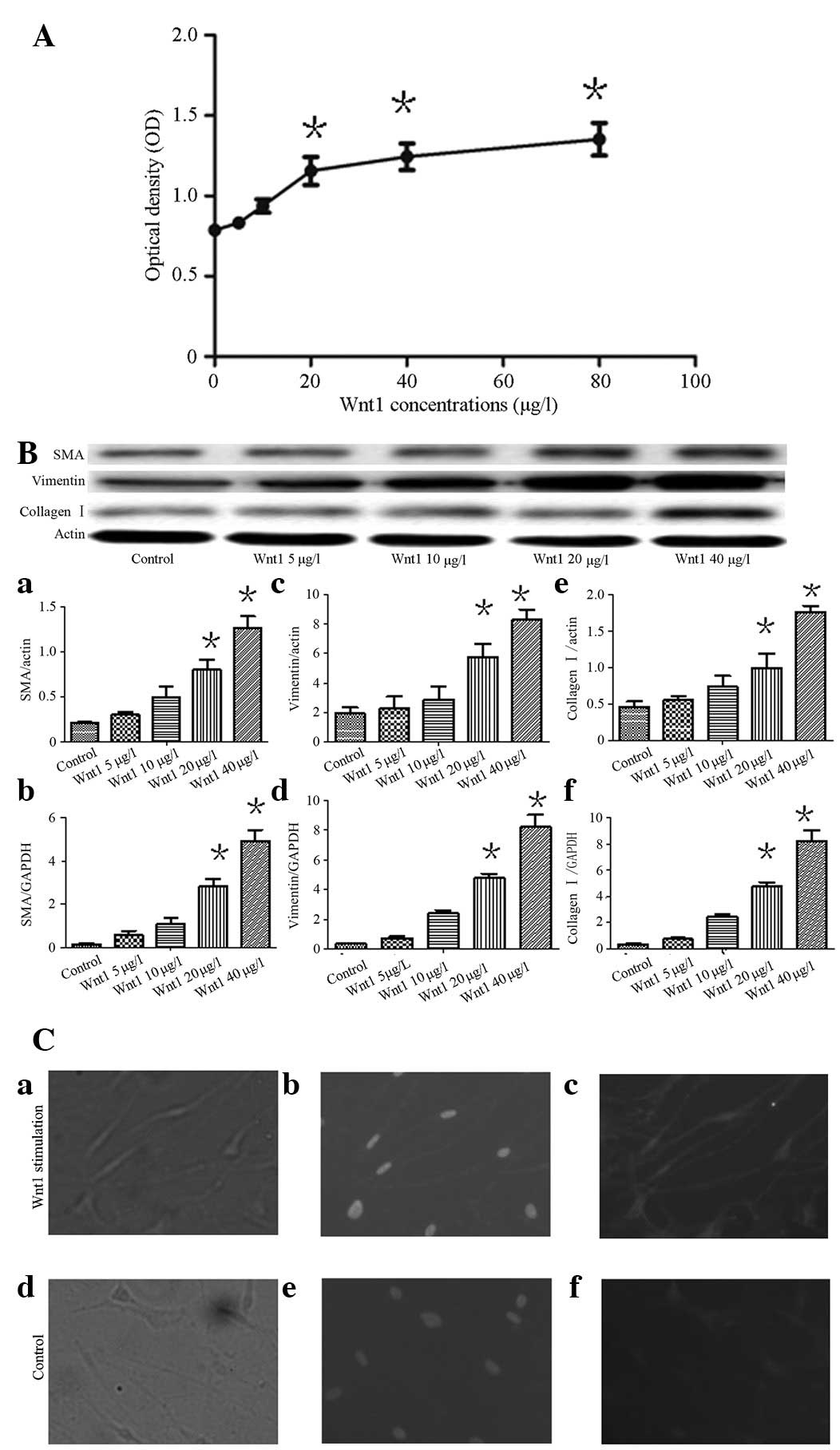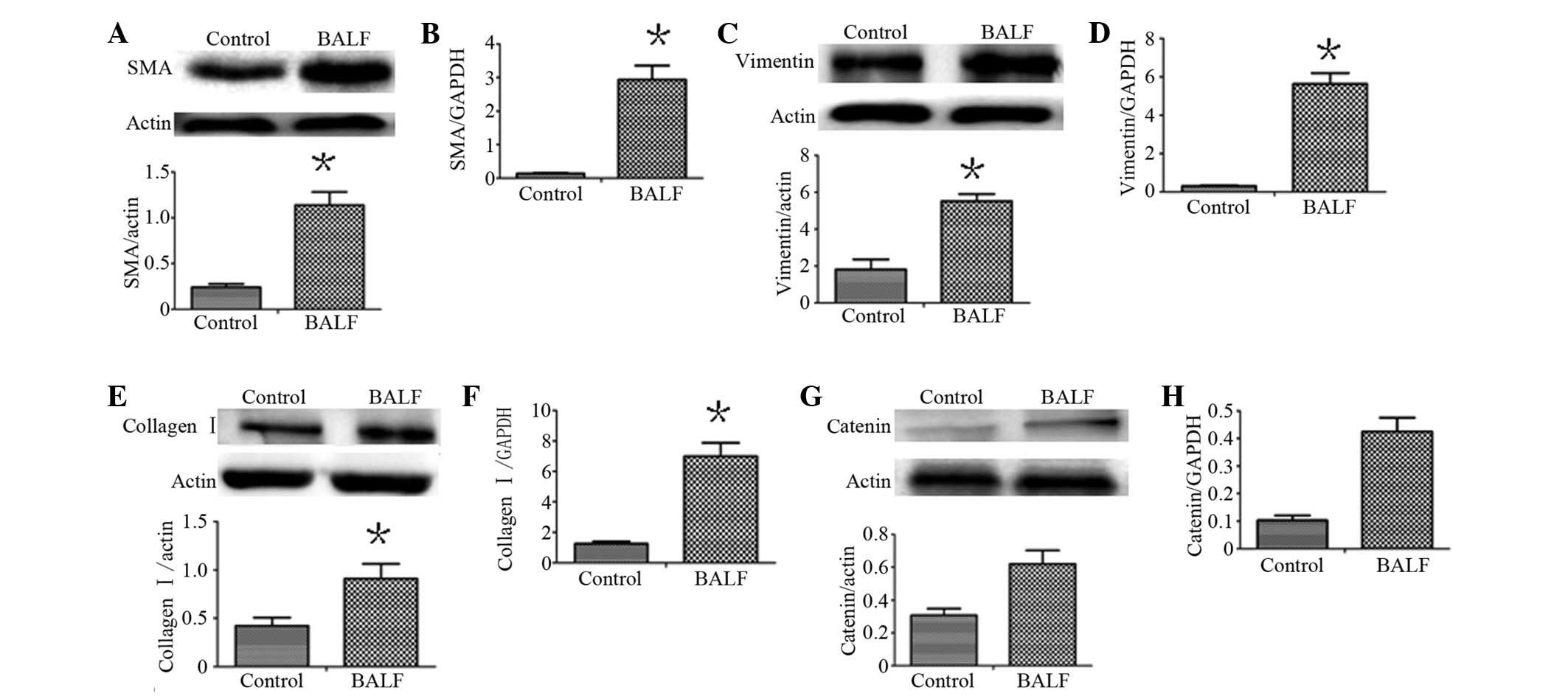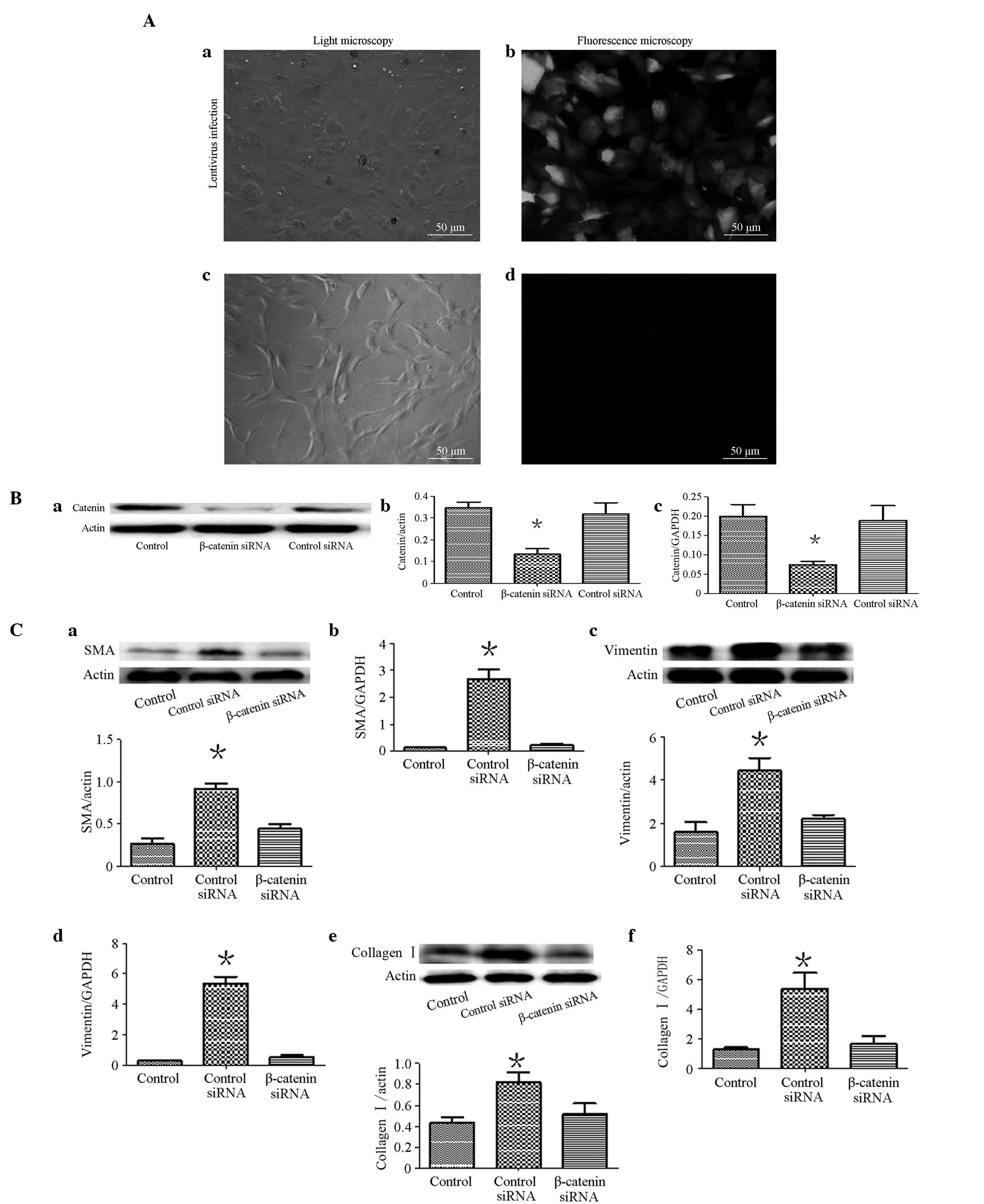|
1
|
Chilosi M, Zamò A, Doglioni C, et al:
Migratory marker expression in fibroblast foci of idiopathic
pulmonary fibrosis. Respir Res. 7:952006. View Article : Google Scholar : PubMed/NCBI
|
|
2
|
Gross TJ and Hunninghake GW: Idiopathic
pulmonary fibrosis. N Engl J Med. 345:517–525. 2001. View Article : Google Scholar : PubMed/NCBI
|
|
3
|
Katzenstein AL, Zisman DA, Litzky LA,
Nguyen BT and Kotloff RM: Usual interstitial pneumonia: histologic
study of biopsy and explant specimens. Am J Surg Pahol.
26:1567–1577. 2002. View Article : Google Scholar : PubMed/NCBI
|
|
4
|
Scotton CJ and Chambers RC: Molecular
targets in pulmonary fibrosis: the myofibroblast in focus. Chest.
132:1311–1321. 2007. View Article : Google Scholar : PubMed/NCBI
|
|
5
|
Meltzer EB and Noble PW: Idiopathic
pulmonary fibrosis. Orphanet J Rare Dis. 3:82008. View Article : Google Scholar
|
|
6
|
Selman M, King TE and Pardo A: Idiopathic
pulmonary fibrosis: prevailing and evolving hypotheses about its
pathogenesis and implications for therapy. Ann Intern Med.
134:136–151. 2001. View Article : Google Scholar : PubMed/NCBI
|
|
7
|
Horowitz JC and Thannickal VJ:
Epithelial-mesenchymal interactions in pulmonary fibrosis. Semin
Respir Crit Care Med. 27:600–612. 2006. View Article : Google Scholar : PubMed/NCBI
|
|
8
|
Selman M and Pardo A: Idiopathic pulmonary
fibrosis: an epithelial/fibroblastic cross-talk disorder. Respir
Res. 3:32002. View
Article : Google Scholar : PubMed/NCBI
|
|
9
|
Chilosi M, Poletti V, Zamò A, et al:
Aberrant Wnt/beta-catenin pathway activation in idiopathic
pulmonary fibrosis. Am J Pathol. 162:1495–1502. 2003. View Article : Google Scholar : PubMed/NCBI
|
|
10
|
Guo Y, Xiao L, Sun L and Liu F:
Wnt/beta-catenin signaling: a promising new target for fibrosis
diseases. Physiol Res. 61:337–346. 2012.PubMed/NCBI
|
|
11
|
Königshoff M, Balsara N, Pfaff EM, et al:
Functional Wnt signaling is increased in idiopathic pulmonary
fibrosis. PLoS One. 3:e21422008.PubMed/NCBI
|
|
12
|
Lawson WE, Polosukhin VV, Stathopoulos GT,
et al: Increased and prolonged pulmonary fibrosis in surfactant
protein C-deficient mice following intratracheal bleomycin. Am J
Pathol. 167:1267–1277. 2005. View Article : Google Scholar : PubMed/NCBI
|
|
13
|
Jiang D, Liang J, Campanella GS, et al:
Inhibition of pulmonary fibrosis in mice by CXCL10 requires
glycosaminoglycan binding and syndecan-4. J Clin Invest.
120:2049–2057. 2010. View
Article : Google Scholar : PubMed/NCBI
|
|
14
|
Jiang D, Liang J, Hodge J, et al:
Regulation of pulmonary fibrosis by chemokine receptor CXCR3. J
Clin Invest. 114:291–299. 2004. View
Article : Google Scholar : PubMed/NCBI
|
|
15
|
Meuten T, Hickey A, Franklin K, et al:
WNT7B in fibroblastic foci of idiopathic pulmonary fibrosis. Respir
Res. 13:622012. View Article : Google Scholar : PubMed/NCBI
|
|
16
|
Chen S, McLean S, Carter DE and Leask A:
The gene expression profile induced by Wnt 3a in NIH 3T3
fibroblasts. J Cell Commun Signal. 1:175–183. 2007. View Article : Google Scholar : PubMed/NCBI
|
|
17
|
van der Velden JL, Guala AS, Leggett SE,
Sluimer J, Badura EC and Janssen-Heininger YM: Induction of a
mesenchymal expression program in lung epithelial cells by wingless
protein (Wnt)/β-catenin requires the presence of c-Jun N-terminal
kinase-1 (JNK1). Am J Respir Cell Mol Biol. 47:306–314.
2012.PubMed/NCBI
|
|
18
|
Moon RT, Kohn AD, De Ferrari GV and Kaykas
A: WNT and β-catenin signalling: Diseases and therapies. Nat Rev
Genet. 5:691–701. 2004.
|
|
19
|
Broekelmann TJ, Limper AH, Colby TV and
McDonald JA: Transforming growth factor beta 1 is present at sites
of extracellular matrix gene expression in human pulmonary
fibrosis. Proc Natl Acad Sci USA. 88:6642–6646. 1991. View Article : Google Scholar
|
|
20
|
Salazar KD, Lankford SM and Brody AR:
Mesenchymal stem cells produce Wnt isoforms and TGF-beta1 that
mediate proliferation and procollagen expression by lung
fibroblasts. Am J Physiol Lung Cell Mol Physiol. 297:L1002–L1011.
2009. View Article : Google Scholar : PubMed/NCBI
|
|
21
|
Challa AA and Stefanovic B: A novel role
of vimentin filaments: binding and stabilization of collagen mRNAs.
Mol Cell Biol. 31:3773–3789. 2011. View Article : Google Scholar : PubMed/NCBI
|
|
22
|
Moeller A, Ask K, Warburton D, Gauldie J
and Kolb M: The bleomycin animal model: a useful tool to
investigate treatment options for idiopathic pulmonary fibrosis?
Int J Biochem Cell Biol. 40:362–382. 2008. View Article : Google Scholar
|
|
23
|
Moore BB and Hogaboam CM: Murine models of
pulmonary fibrosis. Am J Physiol Lung Cell Mol Physiol.
294:L152–L160. 2008. View Article : Google Scholar : PubMed/NCBI
|
|
24
|
Biernacka A, Dobaczewski M and
Frangogiannis NG: TGF-β signaling in fibrosis. Growth Factors.
29:196–202. 2011.
|
|
25
|
Carre AL, James AW, MacLeod L, et al:
Interaction of wingless protein (Wnt), transforming growth
factor-beta1, and hyaluronan production in fetal and postnatal
fibroblasts. Plast Reconstr Surg. 125:74–88. 2010. View Article : Google Scholar
|
|
26
|
Cheon SS, Wei Q, Gurung A, et al:
Beta-catenin regulates wound size and mediates the effect of
TGF-beta in cutaneous healing. FASEB J. 20:692–701. 2006.
View Article : Google Scholar : PubMed/NCBI
|
|
27
|
Sato M: Upregulation of the
Wnt/beta-catenin pathway induced by transforming growth factor-beta
in hypertrophic scars and keloids. Acta Derm Venereol. 86:300–307.
2006. View Article : Google Scholar : PubMed/NCBI
|
|
28
|
Satterwhite DJ and Neufeld KL: TGF-beta
targets the Wnt pathway components, APC and beta-catenin, as Mv1Lu
cells undergo cell cycle arrest. Cell Cycle. 3:1069–1073. 2004.
View Article : Google Scholar : PubMed/NCBI
|
|
29
|
Cheon SS, Nadesan P, Poon R and Alman BA:
Growth factors regulate beta-catenin-mediated TCF-dependent
transcriptional activation in fibroblasts during the proliferative
phase of wound healing. Exp Cell Res. 293:267–274. 2004. View Article : Google Scholar
|
|
30
|
Ulsamer A, Wei Y, Kim KK, et al: Axin
pathway activity regulates in vivo pY654-β-catenin accumulation and
pulmonary fibrosis. J Biol Chem. 287:5164–5172. 2012.PubMed/NCBI
|
|
31
|
Zhou B, Liu Y, Kahn M, et al: Interactions
between β-catenin and transforming growth factor-β signaling
pathways mediate epithelial-mesenchymal transition and are
dependent on the transcriptional co-activator cAMP-response
element-binding protein (CREB)-binding protein (CBP). J Biol Chem.
287:7026–7038. 2012.
|
|
32
|
Gurujeyalakshmi G, Wang Y and Giri SN:
Taurine and niacin block lung injury and fibrosis by
down-regulating bleomycin-induced activation of transcription
nuclear factor-kappaB in mice. J Pharmacol Exp Ther. 293:82–90.
2000.PubMed/NCBI
|
|
33
|
Izumo T, Kondo M and Nagai A: Effects of a
leukotriene B4 receptor antagonist on bleomycin-induced pulmonary
fibrosis. Eur Respir J. 34:1444–1451. 2009. View Article : Google Scholar : PubMed/NCBI
|
|
34
|
Robb WB, Condron C, Moriarty M, Walsh TN
and Bouchier-Hayes DJ: Taurine attenuates radiation-induced lung
fibrosis in C57/Bl6 fibrosis prone mice. Ir J Med Sci. 179:99–105.
2010. View Article : Google Scholar : PubMed/NCBI
|
|
35
|
Jiang C, Huang H, Liu J, Wang Y, Lu Z and
Xu Z: Fasudil, a rho-kinase inhibitor, attenuates bleomycin-induced
pulmonary fibrosis in mice. Int J Mol Sci. 13:8293–8307. 2012.
View Article : Google Scholar : PubMed/NCBI
|
|
36
|
Aumiller V, Balsara N, Wilhelm J, Günther
A and Königshoff M: Wntβ-catenin signaling induces IL-1β expression
by alveolar epithelial cells in pulmonary fibrosis. Am J Respir
Cell Mol Biol. 49:96–104. 2013.
|













